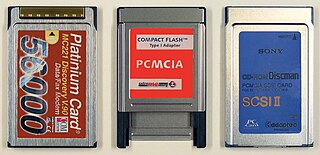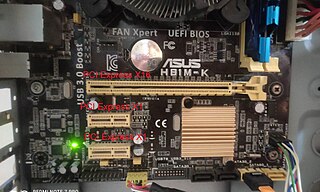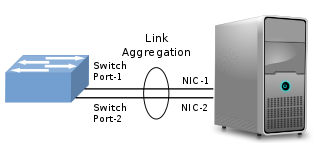
A router is a computer and a networking device that forwards data packets between computer networks. Routers perform the traffic directing functions between networks and on the global Internet. Data sent through a network, such as a web page or email, is in the form of data packets. A packet is typically forwarded from one router to another router through the networks that constitute an internetwork until it reaches its destination node.

Frame Relay is a standardized wide area network (WAN) technology that specifies the physical and data link layers of digital telecommunications channels using a packet switching methodology. Originally designed for transport across Integrated Services Digital Network (ISDN) infrastructure, it may be used today in the context of many other network interfaces.
A network switch is networking hardware that connects devices on a computer network by using packet switching to receive and forward data to the destination device.

PC Card is a parallel peripheral interface for laptop computers and PDAs.

In computing, an expansion card is a printed circuit board that can be inserted into an electrical connector, or expansion slot on a computer's motherboard to add functionality to a computer system. Sometimes the design of the computer's case and motherboard involves placing most of these slots onto a separate, removable card. Typically such cards are referred to as a riser card in part because they project upward from the board and allow expansion cards to be placed above and parallel to the motherboard.

PCI Express, officially abbreviated as PCIe or PCI-e, is a high-speed serial computer expansion bus standard, designed to replace the older PCI, PCI-X and AGP bus standards. It is the common motherboard interface for personal computers' graphics cards, sound cards, hard disk drive host adapters, SSDs, Wi-Fi and Ethernet hardware connections. PCIe has numerous improvements over the older standards, including higher maximum system bus throughput, lower I/O pin count and smaller physical footprint, better performance scaling for bus devices, a more detailed error detection and reporting mechanism, and native hot-swap functionality. More recent revisions of the PCIe standard provide hardware support for I/O virtualization.

A digital subscriber line access multiplexer is a network device, often located in telephone exchanges, that connects multiple customer digital subscriber line (DSL) interfaces to a high-speed digital communications channel using multiplexing techniques. Its cable internet (DOCSIS) counterpart is the cable modem termination system.

ExpressCard, initially called NEWCARD, is an interface to connect peripheral devices to a computer, usually a laptop computer. The ExpressCard technical standard specifies the design of slots built into the computer and of expansion cards to insert in the slots. The cards contain electronic circuits and sometimes connectors for external devices. The ExpressCard standard replaces the PC Card standards.
A CSU/DSU is a digital-interface device used to connect data terminal equipment (DTE), such as a router, to a digital circuit, such as a Digital Signal 1 (DS1) T1 line. The CSU/DSU implements two different functions. The channel service unit (CSU) is responsible for the connection to the telecommunication network, while the data service unit (DSU) is responsible for managing the interface with the DTE. A CSU/DSU can have an external connection point or it can be integrated into a modular card installed in a router.
StrataCom, Inc. was a supplier of Asynchronous Transfer Mode (ATM) and Frame Relay high-speed wide area network (WAN) switching equipment. StrataCom was founded in Cupertino, California, United States, in January 1986, by 26 former employees of the failing Packet Technologies, Inc. StrataCom produced the first commercial cell switch, also known as a fast-packet switch. ATM was one of the technologies underlying the world's communications systems in the 1990s.

In computer networking, link aggregation is the combining of multiple network connections in parallel by any of several methods. Link aggregation increases total throughput beyond what a single connection could sustain, and provides redundancy where all but one of the physical links may fail without losing connectivity. A link aggregation group (LAG) is the combined collection of physical ports.

Catalyst is the brand for a variety of network switches, wireless controllers, and wireless access points sold by Cisco Systems. While commonly associated with Ethernet switches, a number of different types of network interfaces have been available throughout the history of the brand. Cisco acquired several different companies and rebranded their products as different versions of the Catalyst product line. The original Catalyst 5000 and 6000 series were based on technology acquired from Crescendo Communications. The 1700, 1900, and 2800 series Catalysts came from Grand Junction Networks, and the Catalyst 3000 series came from Kalpana in 1994.
In computer networking, an edge device is a device that provides an entry point into enterprise or service provider core networks. Examples include routers, routing switches, integrated access devices (IADs), multiplexers, and a variety of metropolitan area network (MAN) and wide area network (WAN) access devices. Edge devices also provide connections into carrier and service provider networks. An edge device that connects a local area network to a high speed switch or backbone may be called an edge concentrator.
Madge Networks NV was a networking technology company founded by Robert Madge, and is best known for its work with Token Ring. It was a global leader and pioneer of high-speed networking solutions in the mid-1990s, and also made significant contributions to technologies such as Asynchronous Transfer Mode (ATM) and Ethernet.
In computing, Microsoft's Windows Vista and Windows Server 2008 introduced in 2007/2008 a new networking stack named Next Generation TCP/IP stack, to improve on the previous stack in several ways. The stack includes native implementation of IPv6, as well as a complete overhaul of IPv4. The new TCP/IP stack uses a new method to store configuration settings that enables more dynamic control and does not require a computer restart after a change in settings. The new stack, implemented as a dual-stack model, depends on a strong host-model and features an infrastructure to enable more modular components that one can dynamically insert and remove.

The Cisco 2500 series routers are a series of 19" rack mount access routers typically used to connect Ethernet or Token Ring networks via ISDN or leased serial connections. The routers are based on a Motorola 68EC030 CISC processor. This line of routers is no longer sold or supported by Cisco Systems. They were superseded by the Cisco 2600 series, which has also reached EOL now.

A modulator-demodulator or modem is a computer hardware device that converts data from a digital format into a format suitable for an analog transmission medium such as telephone or radio. A modem transmits data by modulating one or more carrier wave signals to encode digital information, while the receiver demodulates the signal to recreate the original digital information. The goal is to produce a signal that can be transmitted easily and decoded reliably. Modems can be used with almost any means of transmitting analog signals, from light-emitting diodes to radio.
Juniper M series is a line of multiservice edge routers designed and manufactured by Juniper Networks, for enterprise and service provider networks. It spans over M7i, M10i, M40e, M120, and M320 platforms with 5 Gbit/s up to 160 Gbit/s of full-duplex throughput. The M40 router was the first product by Juniper Networks, which was released in 1998. The M-series routers run on JUNOS Operating System.

The Juniper MX Series is a family of ethernet routers and switches designed and manufactured by Juniper Networks. In 2006, Juniper released the first of the MX-series, the MX960, MX240, and MX480. The second generation routers, called MX "3D", were first released in 2009 and featured a new Trio chipset and IPv6 support. In 2013, the MX routers were improved to increase their bandwidth, and a virtualized MX 3D router, the vMX 3D, was released in 2014. Utilizing the Juniper Extension Toolkit (JET), third party software can be integrated into the routers.

A mobile broadband modem, also known as wireless modem or cellular modem, is a type of modem that allows a personal computer or a router to receive wireless Internet access via a mobile broadband connection instead of using telephone or cable television lines. A mobile Internet user can connect using a wireless modem to a wireless Internet Service Provider (ISP) to get Internet access.













